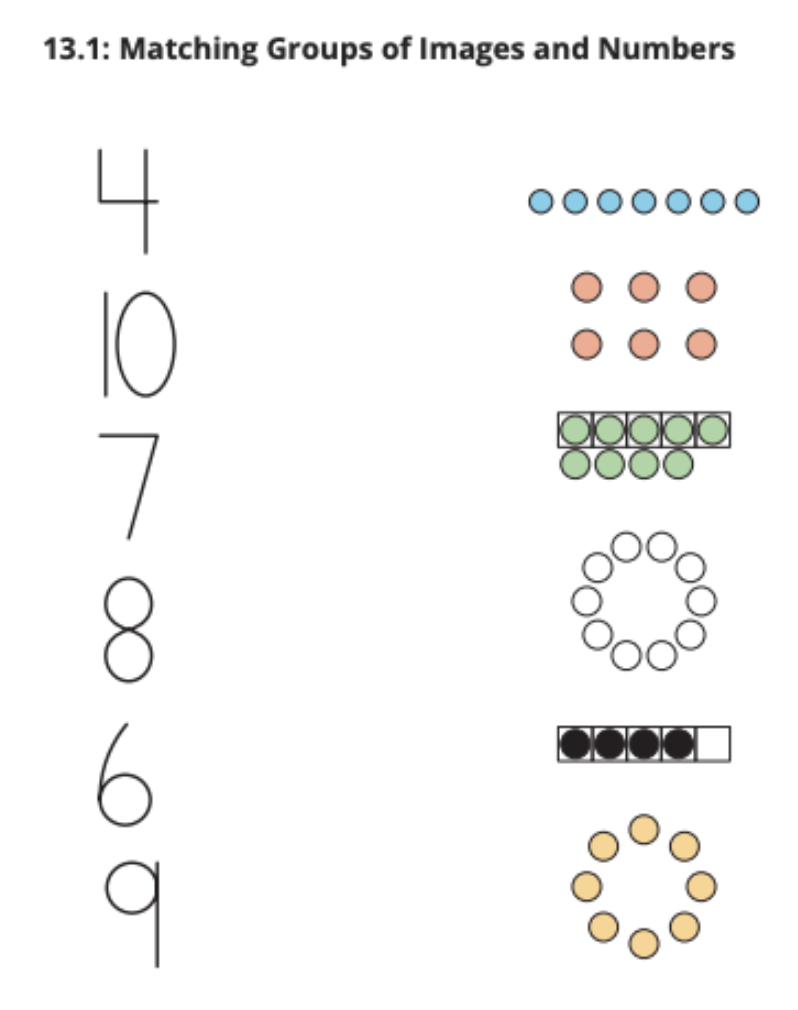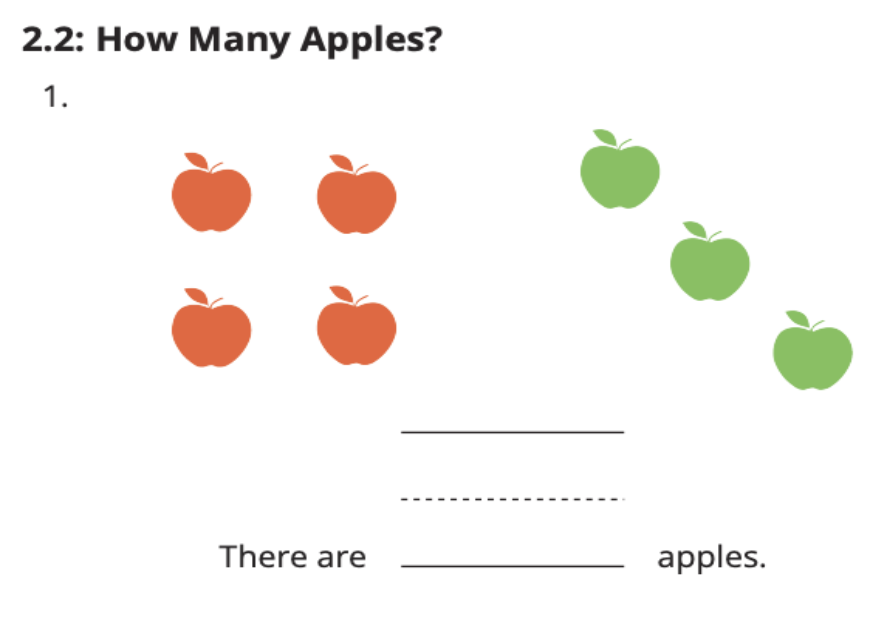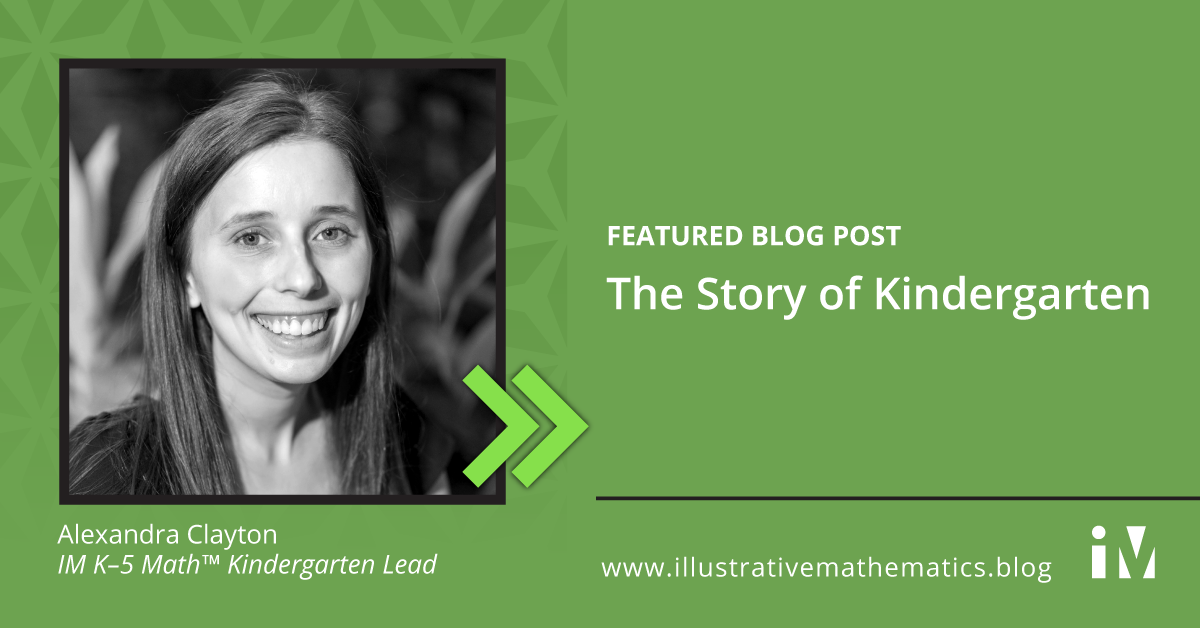By Alexandra Clayton
Many 5 year olds love to tell you (and show you) how high they can count. This skill of rote counting, saying the counting words in the same order each time, is a lot like singing the ABCs . While students may sing “l-m-n-o-p”, they may not know that “m” is a letter or what sound “m” makes or that “m” is the first letter in math. The same can be true with counting. Students may be able to say the numbers from 1 to 50, but not have a very good idea what “7” means.
Much of our work in kindergarten is about developing this understanding: Why do we count? What does counting tell us? What exactly is 7? Let’s look at how we develop these ideas in kindergarten.
Counting and Cardinality in Unit 2: Numbers 1–10
One of the things you’ll notice throughout the kindergarten course is that we rarely tell students to count. Instead, we ask “How many are there?” This may seem like a small shift, but it is important for a few reasons:
- We want students to feel like counting is a way to solve problems and gain information about their world, rather than a task to be performed. Students are naturally curious about how many things there are, and counting is one way to find out!
- We want to develop students’ understanding of cardinality, that the last number when counting tells us how many objects there are and represents all of the objects counted. (K.CC.B.4.b). Without an understanding of cardinality, students may count a group of objects but not be able to tell you how many there are.
Objects, Images, and Numbers
The first section of Unit 2 is Section A: Count and Compare Groups of Objects. It is easier to work with objects because they can be moved around. Students can move each object as they count it, which helps them ensure that they count each object only one time. When comparing, the objects can be lined up and matched so that students can see which group has more. Then students work with images in Section B: Count and Compare Groups of Images. Counting each image only one time is more challenging because they cannot be moved around, so students develop methods of keeping track of what they’ve counted.
It is important for students to be able to make connections between many representations. 7 pattern blocks, 7 butterflies, the written number 7, and the spoken word “seven” are all representations of 7. These important connections are happening throughout Section C: Connect Quantities and Numbers. Students count out a given number of objects, which requires them to keep track of their goal (I need 9 counters) while counting. They match written numbers to groups of objects and images, like in this activity in Unit 2, Lesson 13:

How does this activity bring together the work that students have been doing throughout the unit?
Comparing Numbers
Now that students have looked at many different representations of numbers, they use these different representations to compare written numbers in Section D: Compare Numbers. They may use objects or draw pictures to represent each number and then figure out which is more or less. Or they might compare the numbers using what they’ve learned about the count sequence over time—that each number is one more than the last (Common Core Math Standard K.CC.B.4.c).
While the focus of Unit 3: Flat Shapes All Around Us is on geometry, students continue to practice counting and comparing through questions like “How many rectangles do you have?” and “Are there fewer triangles or circles?”
From Counting to Unit 4: Understanding Addition and Subtraction
Unit 4 is titled “Understanding Addition and Subtraction,” but our work with counting is far from over. Look at this activity from Unit 4, Lesson 2. How are counting and addition connected in this activity?

Some of the first experiences that students are having with addition are counting two groups of objects. While students are using the counting skills that they have been developing, they are also working on important addition concepts. In the activity, they discuss how many red apples there are, how many green apples there are, and how many apples there are all together.
In Section B: Represent and Solve Story Problems, students work with Add To, Result Unknown and Take From, Result Unknown story problems. After making sense of a story problem, students need to represent it. Let’s look at this story problem from Unit 4, Lesson 10:

Students might use objects or drawings to represent the story, building off their work from Unit 2. For example, students may count out 3 cubes to show the 3 apple slices at the picnic. Then they may take out 5 more cubes to show the apple slices Tyler’s dad brought to the picnic.
Now that they’ve shown what is happening in the story, what is left for students to do? Count! Students count all of the counters to figure out that there are 8 apple slices at the picnic. While students may try other methods throughout the year (e.g. recognizing some sums, subitizing, knowing that when one is added the answer is the next counting number), the focus throughout kindergarten is on counting to solve addition and subtraction story problems.
Unit 5: Composing and Decomposing Numbers to 10
In the Common Core Standards, kindergartners are expected to ”understand addition as putting together and adding to, and understand subtraction as taking apart and taking from.” Sometimes teachers focus on adding to and taking from, and skip over putting together and taking apart. In Unit 5 of Kindergarten (Composing and Decomposing Numbers to 10), we pay special attention to putting together and taking apart.
If you think back to the activity where students are counting apples, what they are really doing is putting together red apples and green apples to figure out how many apples there are. Students work on making (composing) and breaking apart (decomposing) numbers throughout this unit. They use objects and drawings to discover different ways to make and break apart numbers, including in story problems like this one from Unit 5, Lesson 7:


Working with larger numbers in Unit 6: Numbers 0–20
In Unit 6, students apply the methods that they developed in Unit 2 and throughout the year to count larger groups of objects and images. When counting larger groups, it can be more challenging to count accurately, so students need to attend to counting each thing only one time and keeping track of what they’ve already counted.
In Unit 7, students also revisit their work with counting, comparing, adding, and subtracting in the context of geometry.
Next Steps
Oh, the places they’ll go!
What begins as rote counting takes us on a journey through much of the major work of the grade. In kindergarten, we have the amazing gift and responsibility to begin building a foundation that students will work on for years to come. How will the work that students do with counting in kindergarten impact them in future years?
Check out the entire Stories of Grades K–5 blog post series:
Story of Kindergarten
Story of Grade 1
Story of Grade 2
Story of Grade 3
Story of Grade 4
Story of Grade 5
You can also download IM’s Stories of Grades K–5 free ebook!
